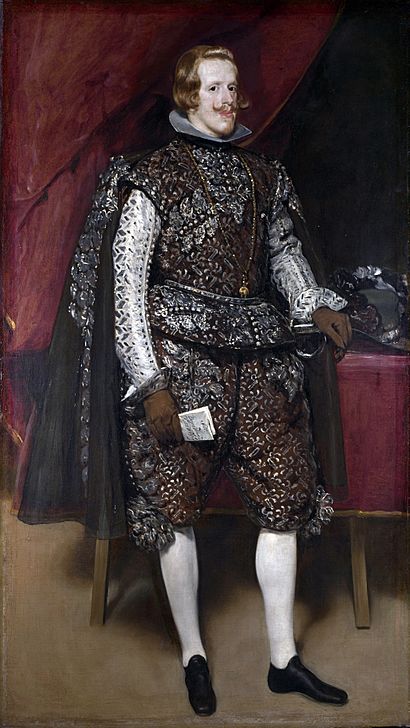Philip IV in Brown and Silver facts for kids
Quick facts for kids Philip IV in Brown and Silver |
|
|---|---|
 |
|
| Artist | Diego Velázquez |
| Year | 1635 |
| Medium | oil on canvas |
| Dimensions | 199 cm × 113 cm (78 in × 44 in) |
| Location | National Gallery, London |
The Portrait of Philip IV is a famous painting by the Spanish artist Diego Velázquez. It is also known as Philip IV in Brown and Silver. Some people even call it Silver Philip. This important artwork shows Philip IV of Spain, who was the King of Spain during Velázquez's time. Today, you can see this painting at the National Gallery in London. Velázquez painted this portrait in the 1630s, and it became a model for many other copies made by his assistants.
The exact year Velázquez finished this painting is not fully known. Some experts say it was around 1631–1632, while others suggest 1635. What we do know is that Velázquez painted it after his first trip to Italy. In Italy, he learned new painting styles, especially from the Venetian school. This made his colors softer and brighter.
This painting is life-size, meaning it's as big as King Philip IV himself. It's special because it doesn't show the King in his usual all-black clothes. Instead, he wears a fancy brown and silver suit. Velázquez painted the tiny details of the suit with quick, small brushstrokes. The King also wears the special symbol of the Order of the Golden Fleece on a gold chain.
If you look closely, you might see some small changes Velázquez made while painting. These are called pentimenti, which means "changes of mind". Velázquez also signed the painting in a unique way. His signature is on a letter that King Philip holds in the portrait. This letter is a made-up request from the painter to the King. Velázquez only signed a few of his paintings, so this shows how important this artwork was to him.
History of the Painting
Where did the painting come from?
This painting was most likely kept in the library at the Escorial, a famous royal palace outside Madrid. It stayed there from the mid-1600s until 1809. That year, Joseph Bonaparte, who was Napoleon's brother and had become King of Spain, ordered it to be moved.
Joseph Bonaparte gave the painting to a French general named Desolle. A Spanish government worker even tried to suggest giving the general a less important painting, but Joseph Bonaparte insisted on this one. After General Desolle passed away, his daughter sold the painting to an English art collector named William Thomas Beckford.
When Beckford died in 1844, his son-in-law, the 10th Duke of Hamilton, inherited it. Later, in 1882, the painting was sold at a big auction called the Hamilton Palace Sale. The National Gallery bought it for £6,300. This was a very high price for a Spanish painting at that time!
See also
 In Spanish: Felipe IV de castaño y plata para niños
In Spanish: Felipe IV de castaño y plata para niños
- List of works by Diego Velázquez

